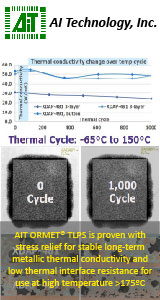|

|
|
| Ask the Experts | |||||||
|
|||||||
|
August 22, 2017 - Updated July 24, 2007 - Originally Posted SMT adhesive problems after wave solder processWe are having issues with glued SMT parts falling off after going through wave solder process. We are using well known SMT adhesive before wave, but still having problems. This issue is erratic with some boards running fine and others will have missing parts after wave. It seems to be a random problem and the PCB is only 6.5" by 4", any assistance would be helpful. Bruce Olver |
|||||||
| Expert Panel Responses | |||||||
|
I don't know if you are dispensing or printing glue but there are advantages to stencil printing. There is much flexibility for stencil glue apertures in controlling the length width and height of the printed glue brick. Glue stencils are very common in the assembly industry.
Vice President Technology Photo Stencil For over 18 years, Dr. Coleman has been the vice president of technology for Photo Stencil, working closely with customers to understand their printing requirements. His efforts have resulted in several new stencil products.
I would immediately suspect board cleanliness. Are the parts falling off with or without the glue? If it is glue to board, then most likely cleanliness. If the failure point is glue to component, there could be some type of formulation change. You can capture this through some type of thermal measurement (TGA or TMA). If you need additional assistance, send me an email.
CEO & Managing Partner DfR Solutions Dr. Hillman's specialties include best practices in Design for Reliability, strategies for transitioning to Pb-free, supplier qualification, passive component technology and printed board failure mechanisms.
There are several common reasons for surface mount adhesives not to provide adequate adhesion during the reflow process. The best way to determine the root cause is to evaluate the failure mode. The first thing to check is to look at the cure profile and make sure the adhesive is cured. Make sure the ovens are set properly and insure the adhesive bondline is getting the proper temperature for the proper time in order to insure a full cure. When looking at the failure: If there is no adhesive on the PWB at the failure locations, or there is a large "crater" it could be outgassing when the PWB hits the wave is blowing off components. This can be due to incompletely cured adhesive absorbing flux or moisture. If the dot of adhesive is still peaked or pointed, or not completely "flattened" then it could be the dot height is not sufficient to touch the component. If the dot of adhesive is flat and has evidence of a fillet where the chip component was resting then it could be an adhesion problem with the component to the glue. It can be that the component has some sort of contaminant (e.g. oil or mold release) that is interfering with the glue adhesion. If a mixed mode failure is observed, it is possible that the adhesive amount is not sufficient to hold the components on during the wave soldering process. In this case looking at the dot profile and pattern should be done to insure that there is sufficient material for the component being glued to the PWB.
Application Engineering Henkel Electronics Dr. Brian Toleno is the Application Engineering Team leader for Henkel Technologies. He is responsible for the technical service and application engineering for Henkel's electronics assembly materials, including solder paste, underfills, PCB protection materials, and underfills.
I hope I'm not stating the obvious here, but often this type of problem is related to a component placement issue, adhesive placement issue, or amount of adhesive issue. I'm writing this from the perspective of an expert on the adhesive dispensing process, but the analysis could be applied to either dispensing or printing. You say the problem is random, however, the first thing I would do is look to see if it is usually the same components randomly falling off, or if the problem is truly random (any component, random time). If the problem usually occurs with the same component or group of components, the problem might be traced to:
Director of Application Engineering Asymtek Mr. Lewis worked for The Aerospace Corporation for 6 years before joining Asymtek in 1993. He holds multiple patents in dispensing technology for electronics assembly and packaging. He has a Master's Degree in Mechanical Engineering from University of Missouri-Rolla.
NOTE: Mr. Lewis is no longer working at Asymtek. The adhesive is either not cured completely or is not wetting to the surface of the PCB. The cure process can be verified fairly easily against the manufacturers specs, if it is a UV cure product check to ensure your UV source is operating properly. The potential for the adhesive not wetting to the surface would have to be traced back to PCB suppliers, batch codes etc. It may be that the solder resist is not completely cured causing an intermittent process failure.
CEO ATEK llc Allen Duck is a 20-year Electronics Industry veteran with Global experience in multiple fields of technology and management. He started A-Tek in 2006 to provide a sales and service channel for international equipment companies wishing to offer value based solutions to USA companies.
Reader Comment
This could be a problem due to inadequate volume of adhesive or it could be an improper curing. Check the adhesive for storage, handling and reflow instructions. Sometimes when the wave height is more and there was back flow of wave, it can also disturb the component. Since the problem is not observed in all PCBs, I strongly suspect the volume and curing of glue.
Subburaj, Amphenol, India
|
|||||||
| Submit A Comment | |||||||
|
Comments are reviewed prior to posting. You must include your full name to have your comments posted. We will not post your email address. |
|
Free Newsletter Subscription
Circuitnet is built for professionals who bear the responsibility of looking ahead, imagining the future, and preparing for it. Insert Your Email Address |
|

|







